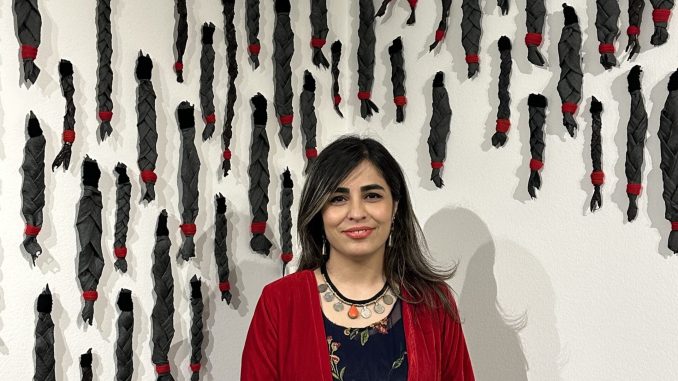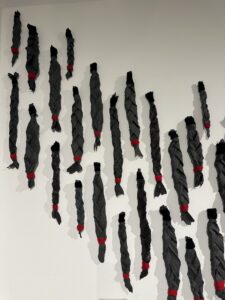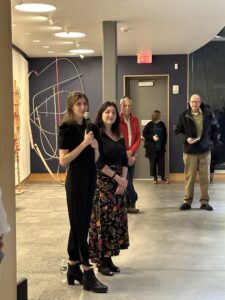
The Berman has officially unveiled its three new collections and is ready for visitors once more. Though each exhibit features a different style of art and message, each of these exhibits originate from female artists and showcase the messages they hold close to their hearts, and each of these new exhibits share a common thread of examining the heavy topic through multimedia pieces. Each of the three artists responsible for the collection spoke.
The main floor showcases Kukulia Velarde’s Free, Total, Faithful, and Fruitful exhibit is a curation of work synthesizing artwork from Peruvian culture as well as European Catholic iconography depicting what womanhood means and drawing from Velarde’s personal experiences with the female identity. Within this, she wanted to focus on why there is so much pain in a woman’s life. The entryway of the museum is filled with works depicting women being controlled or killed, and inside holds multimedia works depicting childbirth and pregnancy – in both its beauty and how it can be used to control women. She herself did not make the decision to have a child until she was forty-five, and was forty-eight by the time she gave birth. “What is it to have a child and not wanting or being prepared,” she said during her talk about a piece with the baby bursting out of the mother’s womb. “Why is it not the woman’s decision?”
On the bottom floor, Adriane Colburn’s exhibit, Paths of Extract, demonstrates the journeys of nature becoming natural resources, particularly focusing on stone, lumber, and oil and gas. She especially highlighted how she uses her art as a research method, involving Caroline Tilson ’24 and Caroline Yuratich ’26 in building her collection. The three major components of the exhibit are the steam bent wood sculpture, the wooden matrix, and a map of the Pennsylvania oil and gas pipelines Tilson and Yuratich researched and tracked. More on her steam bending techniques can be found within issue 1. Colburn thinks of the wooden grid in her exhibit as a matrix due to the information stored within: a picture of the rainbow that appears on the museum’s stone staircase once a day, a rubbing from a tree stump in front of the museum, and more. The woods in this exhibit are all ash, walnut, and cherry, and are from the surrounding areas or are recycled from previous projects. Ash in particular is a research interest of hers especially in how it relates to another global export: the emerald ash borer driving ash to extinction, an imported invasive insect.
A table of books as well as zines created by Tilson and Yuratich accompany the exhibit. “Your research is much more vast than what comes out of it. As an artist that’s always frustrating. One of the reasons I love the zines,” Colburn said.
Sahar Tarighi’s exhibit, Şamaran شاماران: Threads of Transformation, draws from the Şamaran myth when examining the trials facing the Kurdish people today, particularly the violence, assimilation, and genocide the group faces by the countries the Kurdish people are divided into. Tarighi originates from Rojhelat, Kurdistan, today within the borders of eastern Iran. Samaran herself is an ancient myth, a depiction of a woman half-snake and half-human, and traditionally is depicted two-dimensionally. Tarighi takes her and transforms her into three-dimensions, particularly using clay to do so. “I really resonate with it,” she said. The clay feels like she’s “touching it from my ancestors,” and valuing the circulation of how it will return to nature and one day “someone in the future is going to make something out of it.”
Surrounding the depiction of Şamaran on the wall are clay, cut-off braids. These braids are formed out of clay and tied with a black strand of yarn on top and a red on the bottom. The black symbolizes oil, the heart of struggle in the Middle East, as well as death, while the red symbolizes “liveliness, passion, interest” as well as being the color of blood. “The importance of life and death,” she said. The cut-off braid has become a symbol of independence in Iran since the death of 22-year old Mahsa Amini in 2022, who entered a coma hours after being arrested by the morality police and died three days later.
Two students, Caroline Tilson ’26 and Caroline Yuratich ’24 worked alongside Colburn as part of student research into what has built/surrounds the campus. Tilson focused on the stone quarried to build buildings like Bomberger, BPS, and BWC, while Yuratich researched wood and its transport routes, “thinking of wood as a living material and something that moves through space and the country as a spirit.”
The Berman Museum of Art is free and open to the public. Dr. Deborah Barkun, Creative Director of the Berman, emphasized how interdisciplinary the program is and is “very much at its core about the openness of the Ursinus curriculum and asking those types of questions and engaging with artists… Sometimes as a society we put artists on pedestals and don’t think of them as people [using art] to ask these difficult questions.” The Berman is a welcoming space to anyone, regardless of their background with art. “I’m hoping that exhibitions and programming that we’re offering since coming out of lockdown is making the Berman Museum central to life on campus to social life to academic life.” Be sure to check out the full collection anytime from 11am-4pm Tuesdays-Sundays.




